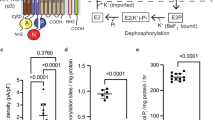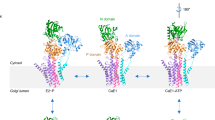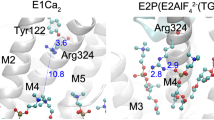Abstract
P-type ATPases are ATP-powered ion pumps that establish ion concentration gradients across cell and organelle membranes. Here, we describe the crystal structure of the Ca2+ pump of skeletal muscle sarcoplasmic reticulum, a representative member of the P-type ATPase superfamily, with an ATP analogue, a Mg2+ and two Ca2+ ions in the respective binding sites. In this state, the ATP analogue reorganizes the three cytoplasmic domains (A, N and P), which are widely separated without nucleotide, by directly bridging the N and P domains. The structure of the P-domain itself is altered by the binding of the ATP analogue and Mg2+. As a result, the A-domain is tilted so that one of the transmembrane helices moves to lock the cytoplasmic gate of the transmembrane Ca2+-binding sites. This appears to be the mechanism for occluding the bound Ca2+ ions, before releasing them into the lumen of the sarcoplasmic reticulum.
This is a preview of subscription content, access via your institution
Access options
Subscribe to this journal
Receive 51 print issues and online access
$199.00 per year
only $3.90 per issue
Buy this article
- Purchase on Springer Link
- Instant access to full article PDF
Prices may be subject to local taxes which are calculated during checkout






Similar content being viewed by others
References
Møller, J. V., Juul, B. & le Maire, M. Structural organization, ion transport, and energy transduction of P-type ATPases. Biochim. Biophys. Acta 1286, 1–51 (1996)
Post, R. L., Hegyvary, C. & Kume, S. Activation by adenosine triphosphate in the phosphorylation kinetics of sodium and potassium ion transport adenosine triphosphatase. J. Biol. Chem. 247, 6530–6540 (1972)
Albers, R. W. Biochemical aspects of active transport. Annu. Rev. Biochem. 36, 727–756 (1967)
de Meis, L. & Vianna, A. L. Energy interconversion by the Ca2+-dependent ATPase of the sarcoplasmic reticulum. Annu. Rev. Biochem. 48, 275–292 (1979)
Mintz, E. & Guillain, F. Ca2+ transport by the sarcoplasmic reticulum ATPase. Biochim. Biophys. Acta 1318, 52–70 (1997)
Toyoshima, C., Nakasako, M., Nomura, H. & Ogawa, H. Crystal structure of the calcium pump of sarcoplasmic reticulum at 2.6 Å resolution. Nature 405, 647–655 (2000)
Toyoshima, C. & Nomura, H. Structural changes in the calcium pump accompanying the dissociation of calcium. Nature 418, 605–611 (2002)
Xu, C., Rice, W. J., He, W. & Stokes, D. L. A structural model for the catalytic cycle of Ca2+-ATPase. J. Mol. Biol. 316, 201–211 (2002)
MacLennan, D. H., Rice, W. J. & Green, N. M. The mechanism of Ca2+ transport by sarco(endo)plasmic reticulum Ca2+-ATPases. J. Biol. Chem. 272, 28815–28818 (1997)
MacLennan, D. H., Brandl, C. J., Korczak, B. & Green, N. M. Amino-acid sequence of a Ca2+ + Mg2+-dependent ATPase from rabbit muscle sarcoplasmic reticulum, deduced from its complementary DNA sequence. Nature 316, 696–700 (1985)
Brandl, C. J., deLeon, S., Martin, D. R. & MacLennan, D. H. Adult forms of the Ca2+ ATPase of sarcoplasmic reticulum. Expression in developing skeletal muscle. J. Biol. Chem. 262, 3768–3774 (1987)
Sagara, Y. & Inesi, G. Inhibition of the sarcoplasmic reticulum Ca2+ transport ATPase by thapsigargin at subnanomolar concentrations. J. Biol. Chem. 266, 13503–13506 (1991)
Toyoshima, C., Nomura, H. & Sugita, Y. Structural basis of ion pumping by Ca2+-ATPase of sarcoplasmic reticulum. FEBS Lett. 555, 106–110 (2003)
Brünger, A. T. Extension of molecular replacement: a new search strategy based on Patterson correlation refinement. Acta Crystallogr. A 46, 46–57 (1990)
Danko, S., Yamasaki, K., Daiho, T., Suzuki, H. & Toyoshima, C. Organization of cytoplasmic domains of sarcoplasmic reticulum Ca2+-ATPase in E1P and E1ATP states: a limited proteolysis study. FEBS Lett. 505, 129–135 (2001)
Juul, B. et al. Do transmembrane segments in proteolyzed sarcoplasmic reticulum Ca2+-ATPase retain their functional Ca2+ binding properties after removal of cytoplasmic fragments by proteinase K? J. Biol. Chem. 270, 20123–20134 (1995)
Ma, H., Inesi, G. & Toyoshima, C. Substrate-induced conformational fit and headpiece closure in the Ca2+ATPase (SERCA). J. Biol. Chem. 278, 28938–28943 (2003)
Andersen, J. P. & Vilsen, B. Amino acids Asn796 and Thr799 of the Ca2+-ATPase of sarcoplasmic reticulum bind Ca2+ at different sites. J. Biol. Chem. 269, 15931–15936 (1994)
Zhang, Z. et al. Detailed characterization of the cooperative mechanism of Ca2+ binding and catalytic activation in the Ca2+ transport (SERCA) ATPase. Biochemistry 39, 8758–8767 (2000)
Orlowski, S. & Champeil, P. Kinetics of calcium dissociation from its high-affinity transport sites on sarcoplasmic reticulum ATPase. Biochemistry 30, 352–361 (1991)
Vilsen, B. & Andersen, J. P. Mutation to the glutamate in the fourth membrane segment of Na+, K+-ATPase and Ca2+-ATPase affects cation binding from both sides of the membrane and destabilizes the occluded enzyme forms. Biochemistry 37, 10961–10971 (1998)
Inesi, G., Ma, H., Lewis, D. & Xu, C. Ca2+ occlusion and gating function of Glu309 in the fluoroaluminate analog of the Ca2+-ATPase phosphoenzyme intermediate. J. Biol. Chem. (in the press)
Einholm, A. P., Vilsen, B. & Andersen, J. P. Importance of transmembrane segment M1 of the sarcoplasmic reticulum Ca2+-ATPase in Ca2+ occlusion and phosphoenzyme processing. J. Biol. Chem. 279, 15888–15896 (2004)
Bilwes, A. M., Quezada, C. M., Croal, L. R., Crane, B. R. & Simon, M. I. Nucleotide binding by the histidine kinase CheA. Nature Struct. Biol. 8, 353–360 (2001)
Hilge, M. et al. ATP-induced conformational changes of the nucleotide-binding domain of Na,K-ATPase. Nature Struct. Biol. 10, 468–474 (2003)
McIntosh, D. B., Woolley, D. G., Vilsen, B. & Andersen, J. P. Mutagenesis of segment 487Phe-Ser-Arg-Asp-Arg-Lys492 of sarcoplasmic reticulum Ca2+-ATPase produces pumps defective in ATP binding. J. Biol. Chem. 271, 25778–25789 (1996)
Cappello, V., Tramontano, A. & Koch, U. Classification of proteins based on the properties of the ligand-binding site: the case of adenine-binding proteins. Proteins 47, 106–115 (2002)
Liu, M. & Barth, A. Mapping interactions between the Ca2+-ATPase and its substrate ATP with infrared spectroscopy. J. Biol. Chem. 278, 10112–10118 (2003)
Clarke, D. M., Loo, T. W. & MacLennan, D. H. Functional consequences of alterations to amino acids located in the nucleotide binding domain of the Ca2+-ATPase of sarcoplasmic reticulum. J. Biol. Chem. 265, 22223–22227 (1990)
Maruyama, K. et al. Functional consequences of alterations to amino acids located in the catalytic center (isoleucine 348 to threonine 357) and nucleotide-binding domain of the Ca2+-ATPase of sarcoplasmic reticulum. J. Biol. Chem. 264, 13038–13042 (1989)
McIntosh, D. B., Woolley, D. G., MacLennan, D. H., Vilsen, B. & Andersen, J. P. Interaction of nucleotides with Asp351 and the conserved phosphorylation loop of sarcoplasmic reticulum Ca2+-ATPase. J. Biol. Chem. 274, 25227–25236 (1999)
Clausen, J. D., McIntosh, D. B., Vilsen, B., Woolley, D. G. & Andersen, J. P. Importance of conserved N-domain residues Thr441, Glu442, Lys515, Arg560, and Leu562 of sarcoplasmic reticulum Ca2+-ATPase for MgATP binding and subsequent catalytic steps. Plasticity of the nucleotide-binding site. J. Biol. Chem. 278, 20245–20258 (2003)
Jacobsen, M. D., Pedersen, P. A. & Jorgensen, P. L. Importance of Na,K-ATPase residue α1-Arg544 in the segment Arg544-Asp567 for high-affinity binding of ATP, ADP, or MgATP. Biochemistry 41, 1451–1456 (2002)
McIntosh, D. B. The ATP binding sites of P-type ion transport ATPases. Adv. Mol. Cell Biol. 23A, 33–99 (1998)
Aravind, L., Galperin, M. Y. & Koonin, E. V. The catalytic domain of the P-type ATPase has the haloacid dehalogenase fold. Trends Biochem. Sci. 23, 127–129 (1998)
Wang, W. et al. Structural characterization of the reaction pathway in phosphoserine phosphatase: crystallographic ‘snapshots’ of intermediate states. J. Mol. Biol. 319, 421–431 (2002)
Lahiri, S. D., Zhang, G., Dunaway-Mariano, D. & Allen, K. N. Caught in the act: the structure of phosphorylated β-phosphoglucomutase from Lactococcus lactis. Biochemistry 41, 8351–8359 (2002)
Eletr, S. & Inesi, G. Phospholipid orientation in sarcoplasmic membranes: spin-label ESR and proton MNR studies. Biochim. Biophys. Acta 282, 174–179 (1972)
Coll, R. J. & Murphy, A. J. Purification of the CaATPase of sarcoplasmic reticulum by affinity chromatography. J. Biol. Chem. 259, 14249–14254 (1984)
Otwinowski, Z. & Minor, W. Processing of X-ray diffraction data collected in oscillation mode. Methods Enzymol. 276, 307–325 (1997)
Brünger, A. T. et al. Crystallography & NMR system: A new software suite for macromolecular structure determination. Acta Crystallogr. D 54, 905–921 (1998)
Collaborative Computational Project No. 4. The CCP4 suite: programs for protein crystallography. Acta Crystallogr. D 50, 760–763 (1994)
Kabsch, W. & Sander, C. Dictionary of protein secondary structure: pattern recognition of hydrogen-bonded and geometrical features. Biopolymers 22, 2577–2637 (1983)
Kraulis, P. J. MOLSCRIPT: a program to produce both detailed and schematic plots of protein structures. J. Appl. Crystallogr. 24, 946–950 (1991)
Hayward, S. Structural principles governing domain motions in proteins. Proteins 36, 425–435 (1999)
Acknowledgements
We thank T. Tsuda for help in many aspects of this work; M. Kawamoto and H. Sakai for data collection at BL41XU of SPring-8; N. Miyashita for making many movies; and Y. Ohuchi for computer programs. We are grateful to D.B. McIntosh for help in improving the manuscript and G. Inesi for communicating unpublished results to us. This work was supported in part by a Creative Science Project Grant from the Ministry of Education, Culture, Sports, Science and Technology, the Japan New Energy and Industry Technology Development Organization, and the Human Frontier Science Program.
Author information
Authors and Affiliations
Corresponding author
Ethics declarations
Competing interests
The authors declare that they have no competing financial interests.
Additional information
The atomic coordinates are deposited in the PDB under accession code 1VFP.
Supplementary information
Supplementary Figure 1
Configuration of cytoplasmic domains (A, N and P) in E2(TG) and E1·AMPPCP in ribbon representation. (JPG 161 kb)
Supplementary Figure 2
Details of the interaction between the A- and P-domains, viewed from the back side. (JPG 249 kb)
Supplementary Figure 3
A solvent flattened map showing the N-domain – P-domain interface calculated from the initial model containing only the P-domain and M3-M10 helices. (JPG 329 kb)
Supplementary Figure 4
A solvent flattened map showing the electron density representing the M1 and M2 helices, calculated from the model excluding them. (JPG 313 kb)
Supplementary Figure 5
Electron density (composite omit and Fo – Fc) maps around AMPPCP calculated for the P21 crystal using the model constructed for the C2 crystal before introducing AMPPCP in the model. (JPG 188 kb)
Supplementary Movie
A movie showing the conformation changes in Ca2+-ATPase for the sequence E2 → E1·2Ca2+ → E1·ATP, made by N. Miyashita using a morphing technique. (MOV 1211 kb)
Supplementary Figure Legends
Legends to the Supplementary Figures 1-5 and Supplementary Movie. (DOC 22 kb)
Supplementary Methods
Detailed description on the structure determination by molecular replacement. Containing one Table showing the progress of refinement. (DOC 29 kb)
Rights and permissions
About this article
Cite this article
Toyoshima, C., Mizutani, T. Crystal structure of the calcium pump with a bound ATP analogue. Nature 430, 529–535 (2004). https://doi.org/10.1038/nature02680
Received:
Accepted:
Published:
Issue Date:
DOI: https://doi.org/10.1038/nature02680
This article is cited by
-
Targeted next-generation sequencing identifies novel variants in candidate genes for Parkinson’s disease in Black South African and Nigerian patients
BMC Medical Genetics (2020)
-
Probing the effects of nonannular lipid binding on the stability of the calcium pump SERCA
Scientific Reports (2019)
-
Essay on Biomembrane Structure
The Journal of Membrane Biology (2019)
-
Crystal structure of the potassium-importing KdpFABC membrane complex
Nature (2017)
-
Protein–phospholipid interplay revealed with crystals of a calcium pump
Nature (2017)
Comments
By submitting a comment you agree to abide by our Terms and Community Guidelines. If you find something abusive or that does not comply with our terms or guidelines please flag it as inappropriate.



